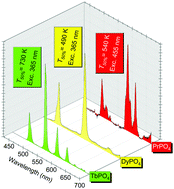Comparing the optical properties and thermal stability of green (TbPO4), yellow (DyPO4), and red (PrPO4) emitting single crystal samples†
Abstract
Blue, green and red-emitting phosphors for near-UV/blue based phosphor blend converted white-light emitting devices have been investigated extensively over the past years. Herein, we present our results on the optical spectroscopy of single crystal samples of TbPO4, DyPO4 and PrPO4 exhibiting prominent emission at green (545 nm), yellow (574 nm) and red (616 nm) region of the electromagnetic spectrum, respectively. We study the temperature dependence of their emission spectra for excitations at 365 and 455 nm, to mimic experimental conditions for phosphor converted light emitting diodes, to show that their thermal quenching temperature is 730 K for TbPO4 (excitation 365 nm), 490 and 520 K for DyPO4 (excitation at 365 and 455 nm), and 540 K for PrPO4 (excitation 455 nm). The TbPO4 emission does not show any considerable blue/red shift at elevated temperatures, while DyPO4 emission is observed close to the center of CIE coordinate diagram. The PrPO4 sample possesses high color purity which shows slight yellow-shift at elevated temperatures. The ground state of Pr3+ and Tb3+ are found to be within the band gap suggesting that both are able to trap holes from the valence band as evinced from the thermoluminescence glow curve data which shows peak maxima at 422 and 437 K due to hole release from the Pr4+ and Tb4+, respectively. The result suggests that the samples have large potential for solid state lighting devices upon choice of an appropriate excitation wavelength.



 Please wait while we load your content...
Please wait while we load your content...